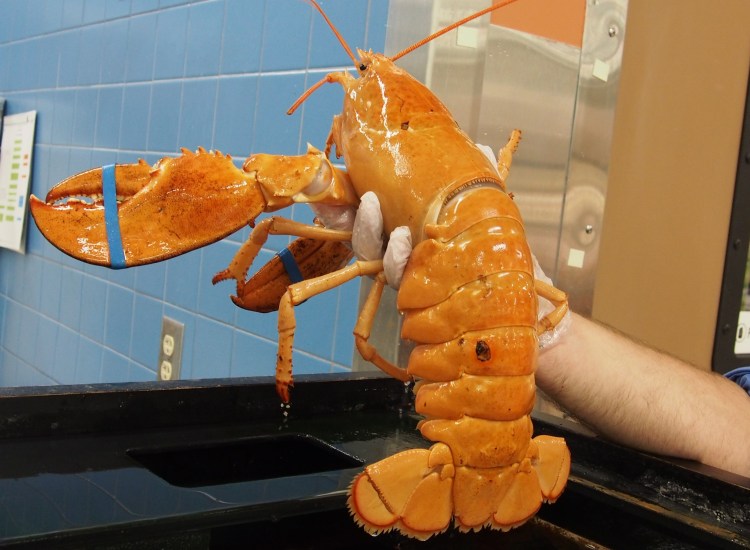The lobster tank – in fact, the entire seafood section – isn’t normally a draw for Marybeth Jeitner when she visits the Publix supermarket in Flagler Beach, Florida.
“I’m actually a vegan,” Jeitner said, and the last time lobster passed her lips was probably 40 years ago.
But when a couple of friends told her about a bright, yellowish-orange lobster in the tank, she decided to swing by Sunday, fell for the crustacean and decided that this was one shellfish that wasn’t destined to end up paired with melted butter.
“I fell in love with her and had to do something,” Jeitner said.
A seafood manager, who had also taken a shine to the lobster, said he heard its bright color – most Mainers would probably say it looked cooked – was extremely rare, although there seems to be a rash of them in New England waters these days: an orange and blue calico lobster was caught last month off New Hampshire.
Scientists say such genetic pigmentation mutations occur in roughly one in every 30 million lobsters.
Jeitner said she shelled out (sorry) $45 for the 2.5-pound female lobster.
Publix was happy to oblige her, she said, and even gave her a $20 gift card in return.
The supermarket also kept the lobster overnight as Jeitner and her friends tried to figure out how to keep a lobster alive in boiling-hot Florida.
She thought she had a solution when Marineland, a local tourist attraction, said she could use its one cold-water tank, apparently a rarity in Florida.
But after they boxed up the lobster – which by then had acquired the name Libbie, for liberation – and drove to Marineland, the tank had gone on the fritz.
Back Libbie went to a jury-rigged tank with seawater scooped up at the local beach and cooled by the repeated addition of frozen water bottles.
Jeitner said finding a final home for Libbie was a chore. She sent out mass emails and at one point considered sending it to a friend’s brother in Rhode Island, who promised to put it in the sea.
But Jeitner thought that Libbie’s bright color, along with the ordeal she’d been through, would make her easy prey. Jeitner called Seaworld, Disney World and a host of other Florida tourist spots, but found no takers.
Eventually the Seacoast Science Center in Rye, New Hampshire, took her in.
Jeitner got some help with shipping costs and packing tips from Mark Murrell, who runs getmainelobster.com, an online lobster company. Most of his lobsters are destined for a dinner table, but they have to get there alive. With his guidance, Libbie got to New Hampshire safely. At last report, Jeitner said, the lobster was moving around and eating, though she’ll be quarantined for a few days before she’s put in one of the main exhibit tanks.
It’s not clear where Libbie came from. An email to Publix’ public relations staff didn’t get a response by Friday night, but Murrell said Maine would be a good guess, since it dominates the market and most Canadian lobstering grounds haven’t opened for the season.
Jeitner said Libbie might not be her last lobster liberation.
“I would like to save all the lobsters,” she said. “I’d like to take the whole tank and set them free.”
Jeitner said she used to visit Maine fairly regularly, with mostly fond memories.
“We used to camp in Maine and we had lobster constantly,” she said. “Of course, I regret it now.”
Copy the Story LinkSend questions/comments to the editors.




Success. Please wait for the page to reload. If the page does not reload within 5 seconds, please refresh the page.
Enter your email and password to access comments.
Hi, to comment on stories you must . This profile is in addition to your subscription and website login.
Already have a commenting profile? .
Invalid username/password.
Please check your email to confirm and complete your registration.
Only subscribers are eligible to post comments. Please subscribe or login first for digital access. Here’s why.
Use the form below to reset your password. When you've submitted your account email, we will send an email with a reset code.